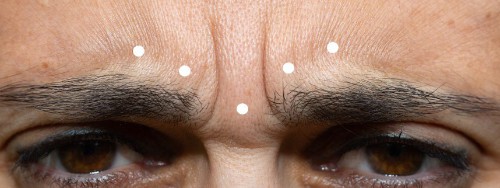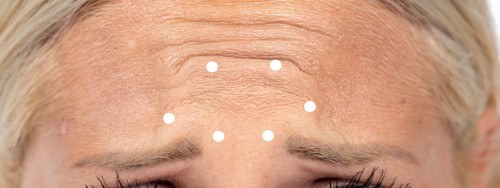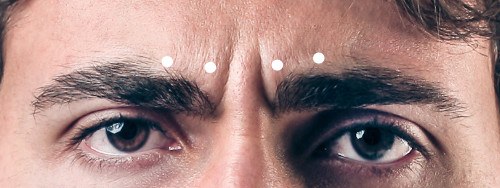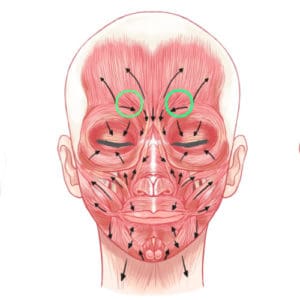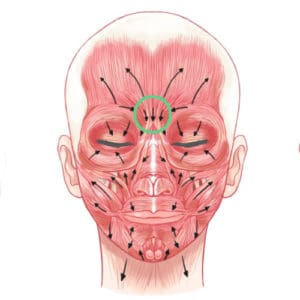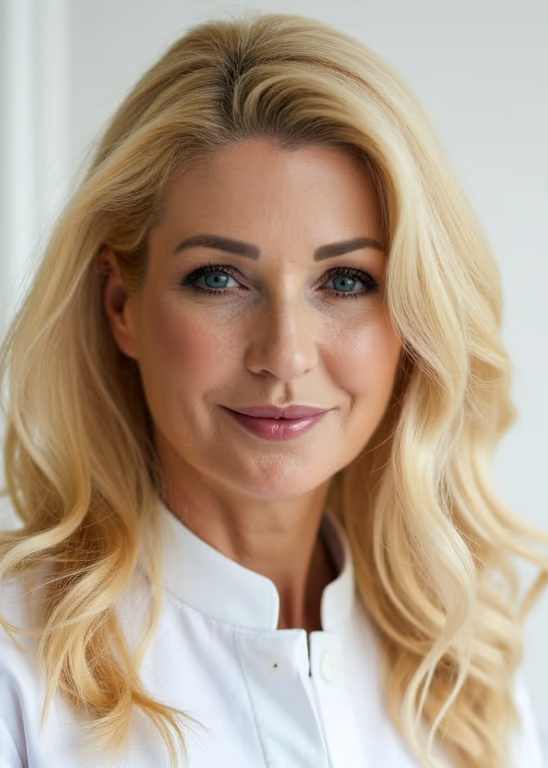Botox for Frown Lines at a Glance
- Botox injections in the frown line specifically weaken the muscles in the glabellar region. This relaxation smooths the area between the eyebrows, visibly reducing or even eliminating the frown line.
- The effect of Botox usually appears within a few days and lasts an average of 4 to 6 months. The treatment can be repeated to maintain the smooth, refreshed appearance.
- The injection procedure is virtually painless and typically does not require anesthesia, as only very fine needles are used.
- Mild redness, swelling, or small bruises may occur after treatment but usually subside within two to three days.
- Because a Botox treatment for frown lines involves no downtime, you can immediately return to normal social and professional activities.
- The treatment time is approximately 30–45 minutes for the first session and around 15 minutes for follow-up appointments.
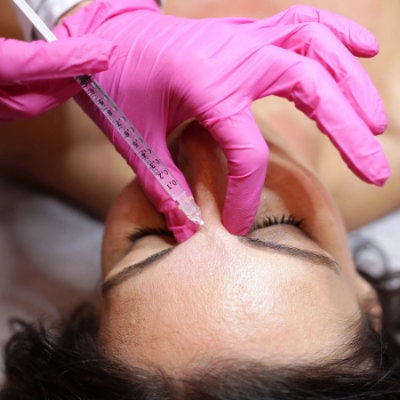
Table of Contents:
- Causes of Frown Lines
- Types of Frown Lines
- Muscles Involved in Frown Line Formation
- Who Is a Good Candidate for Botox Frown Line Treatment?
- Who Should Avoid Botox for Frown Lines?
- Treatment Procedure
- Results and Longevity
- Risks and Possible Side Effects
- Alternatives to Botox for Frown Lines
- Botox Frown Line Treatment Cost in Munich
- Frequently Asked Questions
- Why Choose Dr. Eva Maria Strobl for Botox Frown Line Treatment in Munich?
Who Is a Good Candidate for Botox Frown Line Treatment?
Botox for frown lines is suitable for most adults who wish to soften expression lines between the eyebrows and achieve a more relaxed, approachable look. Ideal candidates are individuals who:
- Have visible vertical lines or a persistent furrow between the brows, even at rest
- Notice that their facial expression appears tense, angry, or tired despite feeling well
- Seek a non-surgical, quick, and minimally invasive solution
- Want natural-looking results without changing their facial features
- Are in good overall health and not pregnant or breastfeeding
- Have realistic expectations regarding the results and longevity of treatment
Botox can also be an excellent preventive treatment for younger patients who want to delay the formation of deeper lines by reducing habitual muscle movement early on.
A detailed consultation and facial assessment are essential to determine whether Botox for frown lines is the most effective and safe choice for your individual anatomy and goals..
Who Should Avoid Botox for Frown Lines??
Although Botox is a safe and well-studied treatment, it is not suitable for everyone. The procedure should be avoided or postponed in the following situations:
- Pregnancy or breastfeeding
- Neuromuscular disorders such as myasthenia gravis, Lambert-Eaton syndrome, or ALS
- Chronic respiratory conditions or difficulty swallowing
- Active skin infections, inflammation, or wounds at the intended injection sites
- Known allergy or hypersensitivity to botulinum toxin or any of its ingredients
- Recent facial surgery or trauma in the treatment area
- Use of certain medications (e.g., aminoglycoside antibiotics, muscle relaxants, or anticoagulants) that may interact with Botox
- Acute illness or fever at the time of treatment
A thorough medical history and assessment are performed before every treatment in my Munich practice to ensure that the treatment can be administered safely and effectively.
Treatment Procedure
- Consultation: Every Botox treatment at my practice in Munich begins with a detailed examination. I analyze your facial expressions, wrinkle pattern, and muscle activity in the glabellar region to determine the exact dosage and injection points. The goal is a natural result that preserves your expressiveness—without a frozen look.
- Skin Preparation
Before treating the frown line with Botox, the skin is thoroughly cleansed and disinfected. A numbing cream can be applied if desired, though this is usually unnecessary, as the injections with ultra-fine needles are almost painless. - Precise Injection of Botulinum Toxin
The botulinum toxin type A (Botox) is injected precisely into the glabellar muscles using a micro-fine needle to smooth the frown line and relax the area. The procedure takes about 10–20 minutes, is performed on an outpatient basis, and requires no anesthesia. Any minor redness or swelling typically subsides within a few hours. - Immediate Aftercare
Following the Botox treatment, the skin may appear slightly red or sensitive for a short time. Cooling the area provides comfort and relief. For about 24 hours, you should avoid exercise, sauna, or tanning, as these could increase circulation and shift the product. - Follow-Up and Adjustment
The effect of Botox in the frown line becomes noticeable after 2–5 days and is fully visible within two weeks. A follow-up appointment after 10–14 days allows evaluation of the results and, if necessary, a small touch-up for a smooth, relaxed, and balanced appearance.
Results and Longevity
The results of Botox for frown lines become visible within a few days and reach their full effect after about two weeks. The treated muscles in the glabellar region gradually relax, causing the frown line to smooth out and the facial expression to appear noticeably more open and calm. Most patients report looking friendlier and more rested, while still maintaining natural facial movement.
The effect typically lasts 4 to 6 months, depending on factors such as individual metabolism, muscle strength, and treatment frequency. With regular maintenance treatments, the muscles tend to stay more relaxed over time, and frown lines become progressively less pronounced.
As the Botox effect wears off, muscle activity slowly returns, and the lines may gradually reappear—but never suddenly. The skin remains smoother than before, since the muscles have been at rest for several months.
Long-term treatment with Botox for frown lines can also have a preventive benefit: by reducing repeated facial muscle contractions, it helps delay the formation of deeper expression lines and supports a naturally youthful appearance.
Risks and Possible Side Effects
Botox for frown lines is a well-tolerated and low-risk procedure when performed by an experienced physician. However, as with any medical treatment, certain side effects can occur:
- Mild redness or swelling at the injection site
- Small bruises (hematomas) that fade within a few days
- Temporary headache or tight sensation in the forehead area
- Minor asymmetries if one muscle responds differently than the other
- Slight drooping of the eyelid or eyebrow (ptosis) in rare cases
- Temporary blurred or double vision, if the product spreads to nearby muscles
- Allergic reactions or hypersensitivity, extremely rare but possible
- Local tenderness or a feeling of heaviness in the treated area
These effects are temporary and usually resolve within days to weeks. To minimize risk, precise injection technique and accurate dosing are essential. In my Munich practice, all injections are performed personally and with the utmost attention to safety and natural results.
Alternatives to Botox for Frown Lines
While Botox remains the most proven and effective method for treating frown lines, there are other options such as hyaluronic acid fillers and laser resurfacing. Each has specific advantages and limitations that should be considered before choosing a treatment.
Frown Line Treatment With Hyaluronic Acid Fillers
Hyaluronic acid fillers are sometimes used as an alternative to Botox to smooth frown lines. The filler gel, a naturally occurring substance that retains moisture, is injected directly into the wrinkle to fill and smooth the skin. The results usually last 6 to 12 months, depending on the product and skin type.
However, injecting the glabellar area with fillers carries particular risks. Sensitive blood vessels that supply the eyes run through this region. If hyaluronic acid is accidentally injected into an artery, it may cause vascular occlusion and, in rare cases, blindness. Such an emergency must be treated immediately, though reversal is not always possible. For this reason, filler injections in the glabella should only be performed by highly experienced physicians.
Laser Resurfacing
Another option for treating frown lines is laser resurfacing. This technique removes the outer skin layer while stimulating collagen renewal in deeper layers, resulting in smoother and firmer skin.
After the procedure, the skin may be red or swollen for a short time, and temporary pigment changes can occur. The skin also needs time to fully regenerate following treatment.
Why Botox Remains the Best Choice
Compared with fillers and laser resurfacing, Botox is generally the safest, fastest, and most cost-effective method for treating frown lines. It effectively smooths expression-related wrinkles without altering your natural facial expressions. For these reasons, I recommend Botox for frown lines whenever it is both medically appropriate and aesthetically beneficial.
Botox Frown Line Treatment Cost in Munich
The cost of Botox for frown lines at my Munich practice is approximately €290. This serves as a general guideline; the actual fee is billed according to the German Medical Fee Schedule (GOÄ) and may vary slightly depending on the case.
Typically, a partial vial of 50 units is sufficient to effectively treat the frown line and glabella. I recommend using the remaining product for complementary areas—such as the forehead or a subtle eyebrow lift—to achieve a balanced overall result. Since opened vials cannot be stored for safety reasons, a full vial is always charged, and any unused product must be discarded.
Please note that Botox treatments for frown lines are considered cosmetic procedures and are not covered by health insurance.
FAQ – Botox Frown Lines
During Botox treatment for frown lines, minor swelling or bruising may occasionally occur. In rare cases, the toxin can spread to nearby areas, temporarily affecting the eyebrows or visual field. For this reason, the procedure should always be performed by a qualified and experienced physician.
Yes. Botox for frown lines is considerably safer than hyaluronic fillers, as the glabellar region is highly vascularized. Injecting fillers in this area can, in extreme cases, cause vascular occlusion and even blindness. For that reason, I always prefer Botox when smoothing frown lines in this region.
Yes. Mild headaches after Botox treatment for frown lines are relatively common and usually harmless. They typically resolve within a few hours and may occasionally be accompanied by mild nausea.
A touch-up every 4 to 6 months keeps the results consistently smooth and prevents the frown line from deepening again.
The muscles gradually regain their activity, and the frown line slowly reappears—but it will not become worse than before the treatment.

About the Author:
Dr. med. univ. Eva Maria Strobl is the owner of LIPS and SKIN Aesthetic Medicine practice in Munich. She is a trained specialist in general medicine (MedUni Vienna) and has over 10 years of specialization in non-surgical aesthetic procedures. Dr. Strobl is a member of the German Society for Aesthetic Botulinum Therapy e.V. (DGBT), the German Society of Anti-Aging Medicine e.V. (GSAAM) and of Network Global Health. She publishes regularly on her blog and on DocCheck.

